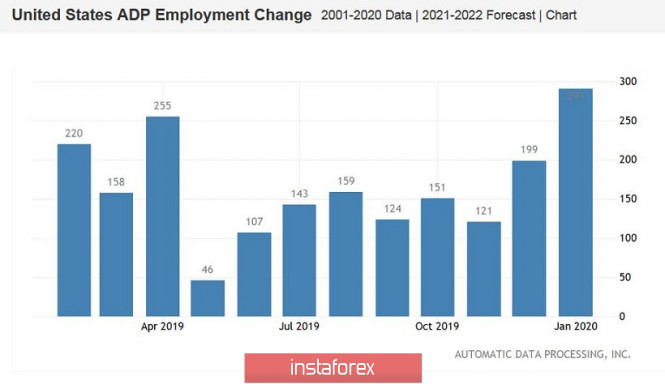The euro-dollar pair is still holding in the area of the 10th figure, despite a group of negative fundamental factors. A strong ADP report, weak production data from Germany, the "coronavirus factor", positive news from China - all these circumstances either put pressure on the euro or strengthen the US currency. Friday's Nonfarm may strengthen the downward movement of EUR/USD, and in this case, the bears of this pair will finally fix in the area of the 9th figure, with the prospect of a further decline to the lows of last year.

Let me remind you that the dollar strengthened throughout the market according to the results of the January meeting of the Fed. Jerome Powell did not surrender once again from the pressure of US President Donald Trump, who called on the Central Bank again to lower the interest rate "two years late." However, the American regulator disappointed the head of the White House - he did not only soften monetary policy, but also erased the fears of many traders about such intentions in the foreseeable future (at least until the summer of this year). On the other hand, the Fed expressed concern about inflation and production indicators. Powell also reminded market participants that the Fed "will not even think about raising the rate" until inflation fixes in the area of the target two percent level.
In other words, the focus of attention of traders shifted to macroeconomic reports from the United States again. Moreover, after the weakening of panic regarding the spread of coronavirus, the market "remembered" the problems of the American economy. Therefore, key statistics can now cause quite strong volatility for the EUR/USD pair. In this context, tomorrow's Non-farm will play a crucial role in determining the direction of further price movement.
Let me remind you that the December data on the growth of the American labor market was disappointing: almost all the components entered the "red zone", reflecting unhealthy trends in the labor market. Only the unemployment rate remained unchanged (at around 3.5%). But in this case, this is not an encouraging fact: this indicator does not respond as quickly to the current situation, as it relates to lagging economic indicators. At the same time, more operational figures were not so optimistic - all components came out below forecast values.
Thus, the indicator of employment growth increased by 145 thousand instead of an increase of 165 thousand. The number of jobs in the manufacturing industry has completely decreased (by 12 thousand). Over the past six months, this indicator has been declining for the second time in the negative area - in particular, it declined immediately by 49 thousand in October. But especially in early January, the nonfarm inflation component was disappointing — the level of average hourly wages. This most important indicator for the Fed was at around 0.1% on a monthly basis (the worst result since last September, when it declined to zero) and 2.9% on an annual basis (worst result since July 2018).
According to the general forecast, January's Nonfarm will show a more significant result. The employment growth rate should rise to 160 thousand, and the average hourly wage should return to a three percent mark. At the same time, the growth rate of those employed in the manufacturing sector of the economy can demonstrate a negative result again, although not as significant as in December (the indicator should be reduced by 4 thousand).
In addition, the published ADP report allows a more optimistic look at tomorrow's release. According to the estimates of specialists of this agency, the number of new jobs immediately increased by 290 thousand, with a preliminary forecast of growth to 155 thousand. Thus, it can be assumed that January's Nonfarm will also exceed forecast levels with a high degree of probability. However, it is worth noting here that if salaries disappoint again, the overall positive effect of a strong release can quickly fail. Therefore, the inflationary component of Nonfarm will play the lead.

It is also worth noting that the EUR/USD pair is under pressure not only due to the strong dollar, but also due to the weakening single currency. In this regard, published data on the growth of production orders was significantly disappointing. The indicator collapsed to -2.1%, instead of projected growth to the level of + 0.6%. This is the most negative result for the last 11 years (to be more precise, the last time the indicator declined to such low values in the fall of 2009). Here, it is necessary to recall that inflation in Germany also slowed down to negative values (on a monthly basis), exerting background pressure on the euro.
Nevertheless, the news from China indirectly supported the dollar. Today, it became known that Beijing will halve the customs tariffs imposed by China on September 1. On the one hand, such a step was provided for by a trade transaction (first phase). On the other hand, the fact of the implementation of the agreements reached maintains interest in risk, including the dollar.
Thus, the EUR/USD pair retains the potential for further decline and the pair may be below the first support level of 1.0980 (the lower line of the BB indicator on the daily chart) tomorrow. If the bears consolidate below the specified target, then the chances of sellers to test the 8th figure will increase in many ways.
The material has been provided by InstaForex Company - www.instaforex.com